Within the cultural narratives of India, it is often recounted that Radha and Krishna eventually had different partners, however, it is the deep affection that they shared as a young couple that is cherished above their unions with others. Yet, it is the timeless love shared between Radha and Krishna, seen as one soul in two bodies, that has been enchanting devotees through the ages. What is noteworthy is that their union transcends mortal understanding and boundaries. It even transcends the regional confines, as is seen in indigenous arts from different regions, evoking a sense of devotion through their portrayal of this divine pair. Let us see how:
1. Mughal Miniature
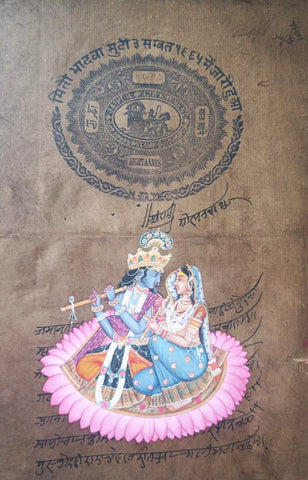
Mughal miniature paintings are deeply rooted in the Persian school of arts, drawing influence from Hindu, Buddhist, and Jain traditions. While Mughal miniature paintings frequently documented majestic spectacles from the Mughal court, royal soirees, and big battle scenes, the miniature painters freely ventured on the mythological subjects. As far as mythological depictions are concerned, Krishna and the love and devotion surrounding this bewitching figure bear numerous instances in the Mughal miniature art. The ornate embellishments, the royal attire and the stately glance shared between Radha and Krishna are well- highlighted through rich tones which elevate the aura surrounding the love-struck couple, who radiate a sense of royalty rather than the simplicity of delicate lovers.
2. Pahari School of Art
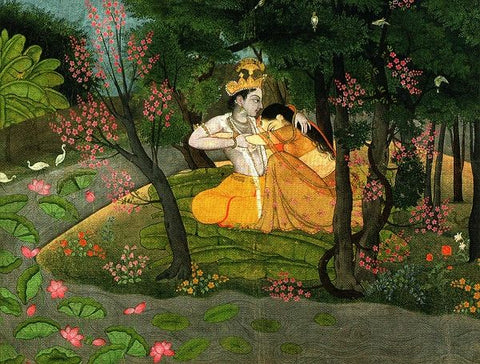
The term Pahari refers to the geographical location of the school, meaning hilly or mountainous. Pahari school of arts has branched out into other schools like Basohli, Guler, and Kangra, some of which can be further subdivided. Flourishing from the 17th to the 19th century, these paintings are popularly known for their depiction of Ashta Nayikas, or the eight heroines, Nala Damyanti and specially the scenes from Jayadeva’s Geet Govinda, dealing with the amorous play between Radha and Krishna. Sometimes, one can see the gopis joining them in the divine play or the pair may be shown alone amidst opulent lush botanical landscapes and rivers. Alternatively, they may be portrayed in courtly settings . Here the poetic essence of Shringara rasa and Bhakti bhava or devotion comes alive through the picturesque portrayal of the scenes.
3. Kishangarh
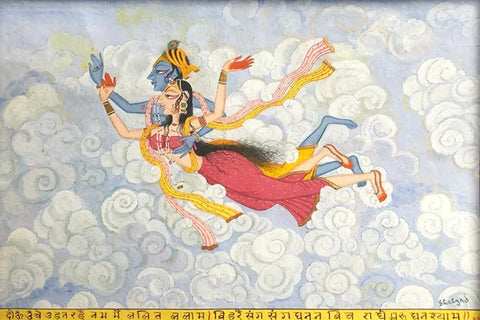
Kishangarh school of paintings have attained great prominence for their portrayal of Radha and Krishna, becoming almost synonymous with this divine duo. Originating in the 18th century, this painting technique flourished under the patronage of Raja Sawant Singh. During its peak, Kishangarh paintings were heavily imbued by the Radha-Krishna bhakti. The natural beauty of picturesque Kishangarh, characterised by its lush vegetation and tranquil environment serves as a fitting backdrop for the artistic expression of devotion. The fusion that adds a layer of enchantment to these paintings is the blending of the vibrant landscape of Kishangarh with the depiction of besotted Krishna with his companion Radha, along with the gopis (cowherd maidens).The features are accentuated by the perfect blend of bold and subtle tones. Lustrous locks, sensuous eyes, and poised body postures are some of the subtle features that add a touch of elegance to the divine imagery.
4. Pichwai

One of the main proponents of the Bhakti tradition, Shree Vallabhacharya is the founding figure of the Pushti Marg tradition in the 16th century. Followers of Pushti Marg shower their devotion and adoration to Shrinathji, a manifestation of 7-year-old form of Krishna, who serves as their central deity. The Pichwai art of Nathdwara revolves around this central figure. These intricately crafted paintings with striking color-schemes often depict various childhood pastimes or leelas of Krishna, such as Krishna with his cows, Krishna lifting Govardhan hill, and Nand Mahotsav. Other prominent themes are Ras lila, portraying Krishna dancing with Radha amidst the love-smitten gopis (female cowherds), Krishna spending quality time with bejeweled Radha on the bank of Yamuna river or kamal talai (lotus pond), at other times he can be seen in engaging with light hearted-banter with Radha and gopis. What is common in most of these paintings is the blissful and ornate portrayal of the entranced Krishna.
5. Kalamkari
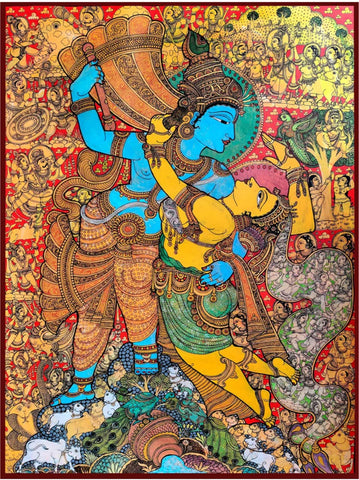
Borrowing its name from the word kalam, meaning pen, Kalamkari art is one of the most detailed forms of paintings created on cotton canvases. Although the history of Kalamkari traces back to thousands of years, the earliest sources trace its inception in the modern day Andhra Pradesh and Telangana to the 17th century. Replete with numerous motifs from peacocks, tigers, to incredible floral designs, the themes of Kalamkari generally revolve around sacred texts such as Ramyana, and Bhagavad Purana. The elaborate artwork of Kalamkari also celebrates the union of Jeevatama and Paramata through the portrayal of Radha and Krishna . The image of the dark-skinned god and his beloved companion, along with other artistic details and components, are so nuanced here that one is stunned by the level of mastery required to achieve such finesse.
6. Kalighat
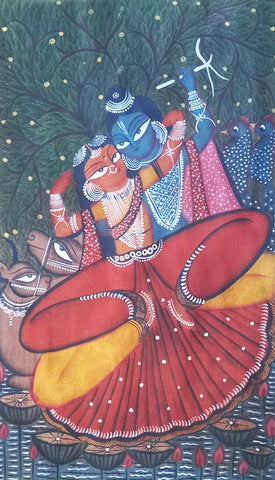
Unequaled in their artistry, Kalighat paintings boast some of the most unique and recurring patterns like no other. It is famously said that Kalighat paintings were first created by Patua scroll artists in the 19th century, who would sell their art in the market places near the Kali temple to the pilgrims and visitors as souvenirs. The bold brush strokes, and dramatic hues are vital for bringing various figures to life, including deities like Durga with her vahana, Saraswati with her veena as well as many modern figures of men and women. Also featured prominently are scenes portraying Krishna in his pastoral role, surrounded by his tender, frolicking cows and playful peacocks as he savors blissful moments with dainty Radha in the forest of Vrindavan. Such paintings exude a sense of peace, enveloping viewers in a serene aura.
7. Madhubani
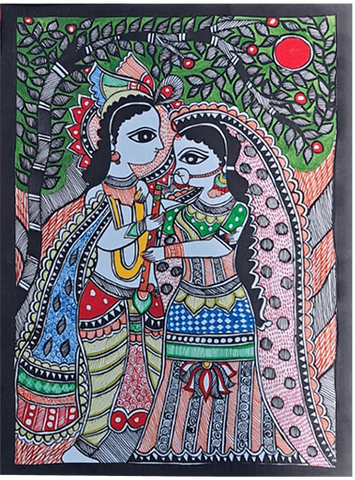
The birthplace of Sita, the Mithila region of Bihar, is also the birthplace of colorful Madhubani art. While it’s no surprise that Madhubani paintings recurrently feature Rama and Sita, Radha and Krishna, another iconic love duo, also grace these canvases. In these mesmerizing paintings, one can witness the divine companions in various romantic settings- sometimes they are depicted swinging on a jhula, and at other times they stand side by side with Krishna serenading Radha with his flute. With its bold palette and skilled hands of women artisans, Madhubani art has been infusing the eternal duo with a vibrant life that never fails to captivate its viewers.
8. Phad painting

The scroll painting of Rajasthan has been captivating its audience through the depiction of epic narratives and indigenous folk lores for centuries. The elaborate art of Phad bears influences from both Mughal as well as Rajput styles. When it comes to portraying Radha and her romantic interest, Phad paintings predominantly feature elements associated with Krishna which includes gopis, peacocks, kamal talai. These narrative scrolls are primarily painted in red, yellow, orange, brown, blue and the outlines are drawn in black. Replete with symbolisms, stories and careful craftsmanship, Phad paintings present multiple settings that exude a playful romance between the divine couple.
9. Kerala Mural

The frescoes of the temples of Kerala tell multiple stories through the artworks. These paintings depicting figures of gods and humans have their origins in Kerala around the 7th to 8th centuries. Heavily influenced by Pallava art and culture, Kerala murals carry a rich history of rise, decline and revival. The transcendental love between Radha and Krishna is vividly portrayed in the Kerala mural paintings using vibrant colours and intricate details. Noteworthy are their fuller lips, voluptuous bodies, and elongated eyebrows, which adds a distinctive charm to this divine pair.
10. Tanjore Painting
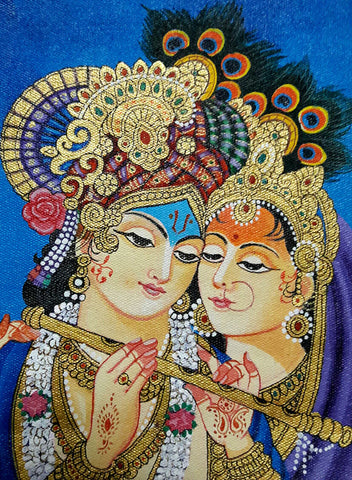
The captivating, classical Tanjore art has been awe-inspiring for ages. The ornate Tanjore paintings have their inception in the city of Thanjavur, 280 km south of Chennai and flourished under the patronage of numerous rulers. Typically, the embossed part of the canvas is covered with gold, giving it an embellished touch. Ganesha, Bal Krishna, Saraswati, Durga are some of the gods commonly portrayed in these lifelike paintings. Among them are depictions of bejewelled and well-decked Krishna along with his beloved Radha in a tranquil state, sharing a profound sense of unity. Isn’t it fascinating to portray timeless love embellished with real gold?
References





















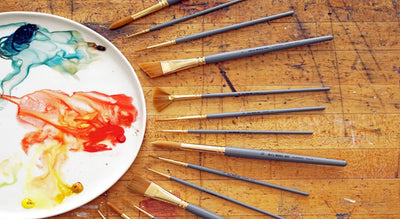
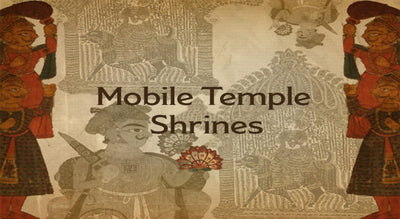








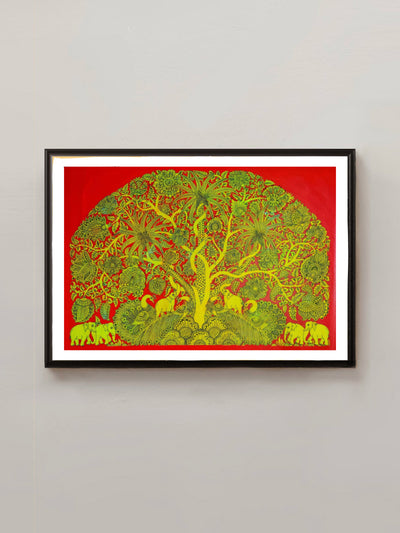








0 comments